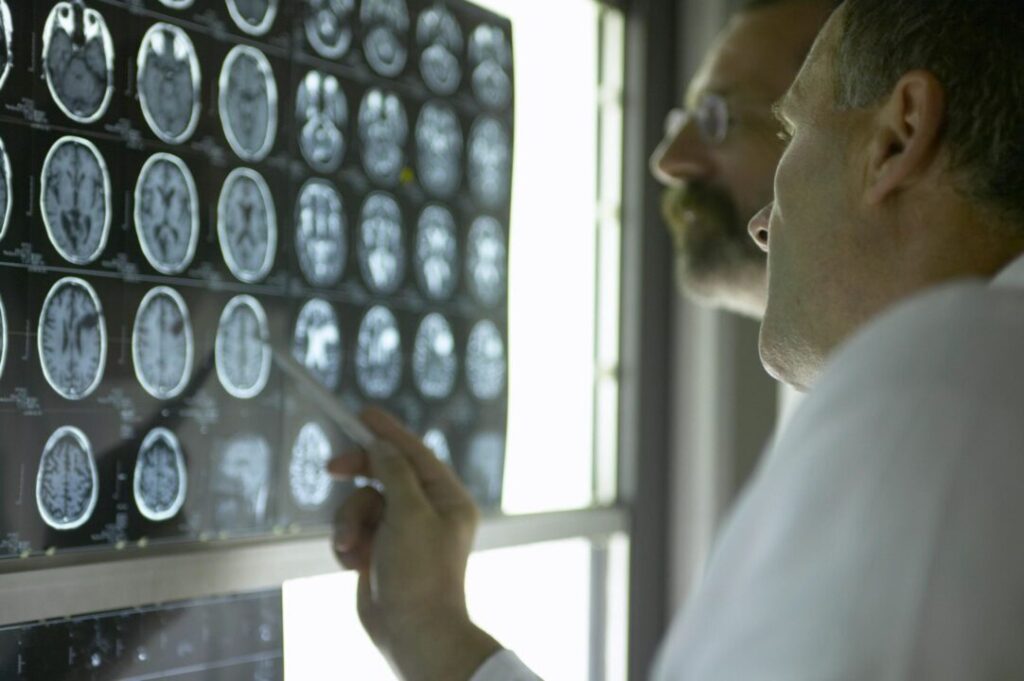
On this page, we will feature short descriptions of different conditions that fall under the frontotemporal dementias.
Behavioural variant of frontotemporal dementia (BV-FTD)
BvFTD is the most common clinical subtype of the frontotemporal lobar-related neurodegenerative diseases. BvFTD is characterized by progressive and persistent changes in personality and behaviour with decline in social skills and executive dysfunction. A diagnosis of possible bvFTD is made if patients display at least 3 of 6 of the following symptoms: apathy, disinhibition, repetitive and/or compulsive behaviours, change in eating habits, decreased empathy, and deficits in executive function. Probable bvFTD is diagnosed if patients also have the classical imaging changes of frontotemporal atrophy or a genetic mutation. BvFTD is the most common presentation among those with an underlying genetic mutation, the most common being mutations in tau (microtubule associated protein tau (MAPT)), progranulin (GRN) or C9orf72. BvFTD is known as a young onset dementia as the mean age of onset is 58 years. Progression rate is variable with a faster progression occurring if associated with motor neuron disease and much slower if not association. The underlying pathology is variable with Tau and TAR-DNA Binding protein 43 (TDP-43) being the most common while fused in sarcoma (FUS) and Alzheimer’s disease are much rarer causes.
- For links to other support groups around the world – www.worldftdunited.net
- Association for Frontotemporal Degeneration (US) – www.theaftd.org
- Rare Dementia Support (UK) – www.raredementiasupport.org
Frontotemporal dementia with motorneuron disease
In recent years, a strong relationship has been demonstrated between FTD and motor neuron disease (MND)/amyotrophic lateral sclerosis (ALS). Approximately 10% of patients who present with ALS go on to develop full-blown dementia, often with features of FTD (more often bvFTD than primary progressive aphasia (PPA)), and up to 50% of ALS patients have evidence of more subtle frontal lobe dysfunction on imaging or neuropsychological testing. Conversely, up to half of patients with FTD are found to have signs of pyramidal dysfunction, with some eventually fulfilling criteria for either ALS or primary lateral sclerosis (PLS). TDP-43 is the pathological protein in more than 95% of clinical ALS, and FTLD-TDP is the cause of half of FTD. The most common mutation in FTLD is C9orf72 that is associated with TDP-43 pathology and can present as either FTD or MND, or both. As a result, FTD and ALS are often considered to represent a clinical spectrum of disease with overlapping pathogenesis.
Primary progressive aphasia
Primary Progressive Aphasia Overview
Primary progressive aphasia (PPA) is a neurodegenerative clinical syndrome that begins with speech and language impairments. Speech and language problems worsen over time. The ability to participate in personal and professional life becomes harder, even though other thinkingabilities, such as memory, are not affected early on. Over time, attention, memory, and judgment can decline. There are three variants of PPA: semantic variant (svPPA), nonfluent agrammatic variant PPA (nfaPPA), and logopenic variant (lvPPA). The behaviors and brain tissue changes ineach of the PPA variants were defined by international experts in 2011(Gorno-Tempini, Hillis, Weintraub, et al., 2011; Mesulam et al., 2014). Each variant has specific speech and language impairments, different patterns of damage in the frontal, parietal and temporal lobes of the brain, predominantly in the left hemisphere, and several neuropathological profiles with proteins in the brain that cause damage to brain cells. There is currently no cure for PPA. However, there is a great deal of evidence that speech-language pathology therapy is beneficial. Researchers also have shown that a form of neuromodulation (transcranial direct current stimulation) combined with speech and language therapy can offer even greater benefit. Below are some examples of the prominent language deficits in each variant.
Non-fluent variant (nfaPPA)
People with nfaPPA also have difficulty coming up with names of objects, use fewer verbs and grammatical constructs and speak slowly and effortfully, sometimes mispronouncing words. They have trouble understanding long and complex sentences but can understand short, simple sentences.
Semantic variant (svPPA)
People with svPPA have difficulty understanding the meanings of words and can be confused about what objects are and how they are used. People with svPPA have difficulty coming up with names of objects and use words like “thing” instead.
Logopenic variant (lvPPA)
People with lvPPA have word-finding problems and difficulty repeating phrases and sentences. Understanding words is not affected.
Sources
Gorno-Tempini ML, Hillis AE, Weintraub S, et al. Classification of primary progressive aphasia and its variants. Neurology. 2011;76(11):1006-1014. doi:10.1212/WNL.0b013e31821103e6
Mesulam MM, Rogalski EJ, Wieneke C, et al. Primary progressive aphasia and the evolving neurology of the language network. Nat Rev Neurol. 2014;10(10):554-569. doi:10.1038/nrneurol.2014.159
Progressive supranuclear palsy (PSP)
Progressive supranuclear palsy (PSP) is the an atypical parkinsonism, meaning that some of its symptoms resemble Parkinson’s disease. The syndrome is typically characterized by difficulty walking with frequent falls and impaired eye movements. Other symptoms include stiffness of arms, legs, neck and back, slowing of movements, altered speech, difficulties swallowing and behavioral changes and cognitive disturbances similar to behavioral variant frontotemporal dementia. Symptoms of PSP typically arise above the age of 60 years, although some persons develop symptoms at an earlier age.
Corticobasal syndrome (CBS)
Corticobasal syndrome (CBS) presents with asymmetric motor symptoms that can resemble Parkinson’s disease, therefore CBS is called an “atypical parkinsonism”. Symptoms typically arise between the ages of 60 and 70 years, but some patients experience there first symptoms at younger or higher age. Symptoms can include stiffness of arms and legs, slowing of movements, muscle spasms/jerks (myoclononus), difficulty in controlling arm and leg movements, and the feeling a limb has a will of its own (alien limb fenomenon). Besides these motor symptoms people can experience similar behavioral changes and cognitive disturbances as seen in behavioral variant frontotemporal dementia and language problems similar to non-fluent variant primary progressive aphasia. Not all these symptoms are present in every patient, CBS is a strongly heterogeneous syndrome: it varies per persons which combination of these symptoms occurs and how fast it progresses.

